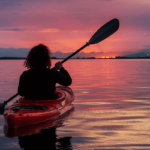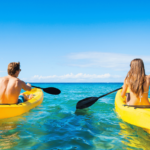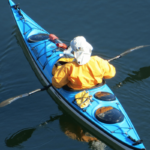Embarking on a canoeing adventure combines the thrill of exploration with the serenity of nature. However, mastering the art of paddling is essential to ensure a smooth and enjoyable journey. Whether you’re a beginner eager to learn or looking to refine your skills, this guide will navigate you through the fundamental techniques of canoe paddling. Discover the secrets to efficient strokes, maintaining balance, and navigating through waters with ease. Let’s set the stage for an unforgettable canoeing experience.
Choosing the Right Canoe Paddle
Selecting the perfect canoe paddle is a pivotal step in optimizing your water adventure. The right paddle not only ensures efficient maneuvering through the water but also enhances your comfort and endurance levels during prolonged periods of paddling. A variety of factors, including the paddle’s length, material, and blade shape, play a crucial role in this selection process. Understanding these elements will lead you to a paddle that complements your paddling style and the conditions you anticipate facing on the water.
The length of the paddle is fundamental to achieving the right balance between power and stroke rate. A paddle that is too long can be unwieldy and tiring to use, while one that is too short may not allow you to effectively reach the water, reducing your canoe’s speed and maneuverability. The material of the paddle also impacts its weight, durability, and overall feel. Lightweight materials such as carbon fiber offer ease of movement and less fatigue, making them ideal for longer journeys. However, wooden paddles are prized for their aesthetic, warmth, and flexibility, providing a traditional paddling experience. The blade shape, another vital consideration, affects the paddle’s efficiency in the water. A wider blade delivers more power for quick acceleration, whereas a narrower blade is better suited for long-distance paddling, requiring less energy per stroke.
When choosing a canoe paddle, it’s essential to consider these aspects in relation to your personal paddling style, physical strength, and the typical conditions of the water bodies you plan to explore. Taking the time to select the right paddle will not only enhance your performance but also increase your enjoyment of the sport.
- Measure your torso to determine the optimal paddle length for your body size.
- Consider the type of canoeing you’ll be doing to select the appropriate blade shape.
- Think about the weight of the paddle and how it will affect your endurance.
- Choose a paddle material that matches your preference for durability, flexibility, and aesthetics.
- Test different paddles, if possible, to find the best fit for your paddling technique and comfort.
Paddling Techniques for Beginners
Navigating a canoe through tranquil waters or challenging rapids requires not just strength but also technique. The essential skills for effective paddling begin with learning how to hold the paddle correctly. Your grip on the paddle should be firm yet relaxed, with one hand at the top of the paddle and the other a few feet down the shaft, ensuring maximum control and efficiency. The power of your stroke comes from your torso, not just your arms. By engaging your core, you not only conserve energy but also generate more powerful movements.
There are several fundamental strokes you should master: the forward stroke, the reverse stroke, and the sweep stroke. The forward stroke is used to propel the canoe forward and requires a deep, fluid motion through the water. The reverse stroke, as the name suggests, moves the canoe backward and is essential for quick stops or maneuvering in tight spaces. The sweep stroke helps in turning the canoe and involves a wide, sweeping motion with the paddle. Understanding and mastering these strokes will significantly enhance your paddling efficiency and enjoyment on the water.
Positioning in the canoe also plays a vital role in your paddling experience. Balance is crucial; sitting or kneeling in the center of the canoe helps in maintaining stability. For those new to canoeing, it might feel wobbly at first, but with practice, you will find your balance and gain confidence on the water. Remember, the key to effortless paddling lies in technique rather than brute force.
Advanced Paddling Strategies
Once you have the basics down, exploring advanced paddling strategies can further enhance your canoeing experience. This includes learning how to read the water, understanding river currents, and mastering more complex maneuvers. Each body of water presents its unique challenges and opportunities for adventure.
| Stroke | Primary Use | Key Benefit |
|---|---|---|
| Forward Stroke | Propulsion | Efficiency in moving forward |
| Reverse Stroke | Maneuvering/Stopping | Control and quick response |
| Sweep Stroke | Turning | Effective directional change |
| J-Stroke | Course Correction | Keeping the canoe straight |
| Draw Stroke | Lateral Movement | Moving sideways without turning |
Mastering the Basic Paddle Strokes
Embarking on a canoeing adventure requires not just enthusiasm but also a fundamental grasp of paddle strokes. These basic techniques are crucial for steering, speed control, and effectively maneuvering your canoe through various water conditions. By mastering these strokes, paddlers can ensure a smooth and enjoyable journey, whether gliding through calm waters or navigating challenging currents.
The forward stroke is essential for propelling the canoe forward. It involves dipping the paddle blade fully into the water close to the canoe and pulling it back towards the paddler, in a straight line parallel to the canoe. This stroke is the backbone of canoeing, allowing paddlers to move efficiently and with direction. The reverse stroke, as the name suggests, is the opposite of the forward stroke and is used to slow down or move the canoe backward. It’s particularly useful for correcting courses or stopping the canoe.
Turning the canoe is achieved with the sweep stroke. For a broad turn, the paddle is placed at the front or rear of the canoe and swept outwards in a wide arc. The draw stroke is used to move the canoe sideways, by reaching out to the side with the paddle and pulling water towards the canoe. These strokes are indispensable for navigating tight spots and avoiding obstacles. Lastly, the J-stroke is a variation of the forward stroke that helps in keeping the canoe straight without switching sides. By adding a slight outward flick at the end of the stroke, the paddler can counter the natural tendency of the canoe to turn with each stroke.
Mastering these basic paddle strokes is not only about technical proficiency but also about developing a harmonious rhythm with the water. With practice, paddlers can enjoy the freedom and serenity that comes from being able to navigate the waters effortlessly.
- Forward Stroke – The fundamental stroke for moving forward
- Reverse Stroke – Used for slowing down or moving backwards
- Sweep Stroke – Essential for turning the canoe
- Draw Stroke – Pulls the canoe sideways, useful for close maneuvers
- J-Stroke – A variation of the forward stroke that helps in keeping the canoe on a straight course
Adjusting Your Grip and Posture
Mastering the art of canoeing begins with the foundational elements of grip and posture. A proper grip on the paddle ensures that you can maneuver the canoe with precision, while the right posture protects your back and shoulders from strain. First, hold the paddle with both hands, keeping them shoulder-width apart. Your hands should grip the paddle lightly but firmly, allowing for fluid movement through the water.
Posture plays a critical role in effective paddling. Sit up straight at the canoe’s center, bending your knees slightly and placing your feet flat on the floor of the canoe for stability. This position maximizes your leverage and power when paddling. Remember, maintaining a good posture not only improves your paddling efficiency but also prevents fatigue, allowing you to enjoy longer journeys on the water.
Furthermore, adjusting your grip and posture according to the canoe’s movement and water conditions is essential for navigating through different environments. Whether gliding through calm waters or steering against strong currents, these adjustments will help you maintain control and balance.
| Element | Description | Benefit |
|---|---|---|
| Grip | Shoulder-width, light but firm | Precision and control |
| Posture | Upright, knees slightly bent | Leverage and power |
| Feet Position | Flat on the floor for stability | Balance and support |
| Adjustments | Adapt to water conditions | Efficiency in various environments |
Adjusting your grip and posture is not a one-time task but a continuous process that evolves with your canoeing experience. As you spend more time on the water, you’ll become more attuned to how slight changes in your grip or posture can significantly affect your paddling performance and overall enjoyment of the sport. Embrace these adjustments as part of the journey, and you’ll find yourself mastering the waters effortlessly.
Navigating Turns and Obstacles
Mastering the art of navigating turns and obstacles in a canoe requires a blend of anticipation, precision, and control. The key to smooth turns lies in understanding the dynamics of your canoe and the water beneath it. To initiate a turn, you must paddle more powerfully on the opposite side of the direction you wish to go. However, the secret to an efficient turn is not just in the power of your strokes but in their timing and rhythm.
When approaching obstacles, your ability to read the water becomes crucial. Look ahead and plan your path, aiming for areas where the water flows smoothly. This might require you to paddle assertively to navigate around rocks or through narrow passages. In some cases, a quick draw stroke (pulling water towards the side of the canoe) or a pry stroke (pushing water away) can help you maneuver with precision. Remember, staying relaxed and flexible in your movements allows you to adapt to changing conditions without overcorrecting or panicking.
Balance is your ally, especially in turbulent waters. Keep your body centered and your weight low in the canoe. This stability will enable you to react swiftly and effectively, whether you’re avoiding an unexpected rock or executing a sharp turn. With practice, navigating through turns and past obstacles will become an intuitive part of your paddling adventures, enhancing both your confidence and enjoyment on the water.
Advanced Techniques for Evasive Maneuvers
As you grow more comfortable with basic navigation, exploring advanced techniques can further enhance your ability to tackle challenging conditions. Learning to perform a lean turn, where you shift your weight to the inside of the turn to tighten the radius, or mastering the art of edging to avoid obstacles at the last moment, can be game-changers. These skills not only improve your agility but also deepen your connection with the canoe and the water.
- Practice smooth, controlled strokes to maintain momentum.
- Anticipate turns well in advance to choose the optimal path.
- Utilize draw and pry strokes for precise maneuvering.
- Maintain a low center of gravity to enhance stability.
- Explore advanced paddling techniques for greater agility.
Paddling in Sync with Partners
Canoeing with a partner blends the art of coordination with the essence of teamwork. The synergy between paddlers is not just about physical alignment but also about harmonizing each stroke to move with precision and grace on the water. The primary goal is to achieve a rhythmic flow that enhances speed, reduces effort, and maximizes enjoyment. To paddle in sync, both partners must communicate effectively, adjust their pacing, and synchronize their strokes.
Effective communication starts with establishing a leader – usually the person in the stern (back) of the canoe, who is responsible for steering and setting the pace. The bow (front) paddler focuses on power and direction, following the stern’s lead. It’s crucial that both paddlers maintain a consistent rhythm, which can be achieved by keeping their strokes parallel and timing their movements to match perfectly. This doesn’t mean mirroring each other’s every move; rather, it involves creating a cohesive pattern that propels the canoe forward smoothly. An important aspect of paddling in harmony is flexibility; partners should be willing to adjust their techniques to complement each other’s strengths and weaknesses.
Another key factor is the physical positioning and movement within the canoe. Both paddlers should ensure they are seated or kneeling securely, maintaining a low center of gravity to enhance stability. Synchronizing strokes requires paying attention not only to the timing but also to the power behind each stroke. The paddlers should work together to find a balance that allows them to move efficiently without exhausting themselves. Coordination becomes easier with practice and patience, as partners learn to anticipate each other’s movements and adapt accordingly.
Enhancing Team Coordination on the Water
Building upon the foundation of synchronization, enhancing team coordination involves practicing specific drills and being mindful of each other’s paddling style. This might include exercises designed to fine-tune stroke alignment and develop a mutual understanding of pacing. The ultimate aim is to operate as a single unit, with each paddler’s actions complementing the other’s. Over time, this level of coordination can lead to a more intuitive and enjoyable paddling experience.
| Aspect | Importance | Tips |
|---|---|---|
| Communication | High | Establish clear signals and roles |
| Rhythm | Critical | Maintain consistent stroke timing |
| Flexibility | Medium | Be willing to adapt and adjust |
| Physical Positioning | Important | Keep a stable and balanced posture |
| Practice | Essential | Regularly work on synchronization drills |
In conclusion, paddling in sync with a partner is an enriching experience that combines the joy of canoeing with the art of teamwork. It demands effective communication, mutual understanding, and a willingness to adjust and align with one another’s movements. With practice and patience, partners can achieve a level of synchronization that not only enhances their performance but also deepens their connection to each other and the water. Whether you’re navigating calm lakes or challenging rapids, the ability to paddle in harmony will make your journey more enjoyable and rewarding.
Remember, the journey on the water is as much about the companionship and the memories created as it is about reaching the destination. So, grab a paddle, find your rhythm, and embrace the adventure that awaits when you and your partner master the waters effortlessly together.
I’m Adam Reynolds, a dedicated sports writer with a passion for both competitive gaming and betting. In my mid-thirties, I dive deep into the world of sports, providing insightful analyses and strategies to help readers make informed betting decisions. My experience spans various sporting events, where I blend my love for the game with a keen eye for betting trends. Whether I’m dissecting game tactics or offering betting tips, I aim to deliver content that is both engaging and practical. Join me as we explore the exciting intersection of sports and betting together.





